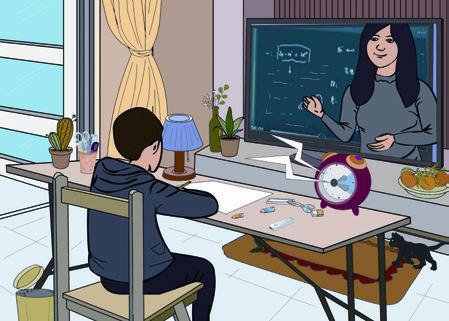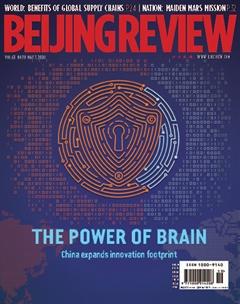Will a New Myopia Prevention Guideline Protect Children’s Eyesight?

In some parts of China, where the novel coronavirus disease (COVID-19) pandemic has been effectively contained, schools are being reopened gradually. But a large number of students must continue with online lessons that have already lasted more than two months.
With many children nationwide had to learn in front of electronic devices, parents and their children, are becoming increasingly concerned about deteriorating eyesight due to lengthy exposure to computer screens. Myopia was a prevailing issue among Chinese students before distance learning was widely applied in response to the coronavirus outbreak. Statistics show that the rate of myopia among students in younger age groups is rising sharply. Since myopia is an almost irreversible condition, it is important to protect students eyesight from the damage that can be caused by online learning.
In light of this, the National Health Commission (NHC) has issued a guideline on myopia prevention during the coronavirus outbreak on April 25, stipulating that online learning for primary school students should be limited to 2.5 hours every day, with a mandatory break every 20 minutes. For middle school students the document decrees four hours per day and breaks every 30 minutes, so as to protect the eyesight of these students.
Parents, children and even schools themselves have shown interest in the new guidelines, although most think its proper implementation is unlikely. Students and schools have a heavy load of learning and teaching objectives to fulfi ll. Regardless, the guideline has, in the eyes of many, highlighted the importance of protecting childrens eyesight and most agree that schools must improve their teaching methods to make this possible.
A good proposal
Zong Qing (Modern Express): Time restrictions on online learning is a good idea that students and parents seem happy to embrace, but it will be hard to implement in real life. If other options less damaging to childrens eyesight were available, then parents would not allow their children to study online, but the coronavirus outbreak has left them with little choice but to accept this solution. Students have to continue studying even if they cant physically go to school for classes.
Such policies and regulation are wellintentioned, but they are easily distorted in practice. Schools and teachers dont want to fall behind in teaching objectives. The time restrictions of every class already present a challenge.
Schools may also require students to do eye exercises, although parents are unlikely to always ensure they do this. Besides, in addition to online lessons students need also finish their homework online after class. It seems unrealistic to limit the time for this to 2.5 hours.
As a result, most parents will shrug at this guideline. However, there may still be a silver lining. If schools are convinced on protecting students eyesight, they may try to shorten online lessons by improving the quality and efficiency of the classes. This may also prevent teachers from adding extra online work, instead encouraging their students to make use of paper books to prepare for and review classes. A break every 20 minutes is also a good proposal, which will help students to stay on task as well as protecting their eyesight.
Less extracurricular class
Feng Shou (guancha.gmw.cn): Preventing myopia among primary and middle school students is not easy. Their eyesight is already endangered by extracurricular activities like online games and remote language classes with teachers outside China.
Now, the outbreak of COVID-19 has forced the majority of Chinas students to take their lessons online, making it even harder to prevent damage to their eyesight. The NHC has only provided a guideline; the key will be for schools and families to enforce it effectively.
Students have been forced to spend a lot of time learning online since schools were closed due to the pandemic. Some have online classes with various educational and training institutions. It is almost impossible for many of them to limit their time online to 2.5 hours or less a day.

Implementing the guideline so as to protect students eyesight will be an important test for both schools and families. Schools should shoulder most of the responsibility for putting the guideline in place. Teachers must prepare adequately before class, so as to fi nish their lessons on time. Education authorities should also supervise whether schools are complying with the guideline on time limits by surveying parents over the phone.
For families, it is more important than ever before to protect the health of their children, including their eyesight. By cooperating with schools, parents can ensure that their children attend every class online, while at the same time paying attention to the length of each lesson. They can also help by not adding extra online classes by educational institutions to their childrens curriculum. Skipping a few extracurricular classes is a small price to pay for their childrens long term visual health.
Sha Yuansen (Qilu Evening News): Whether the NHC s guideline can really help to protect students eyesight hinges on whether the education authorities truly value students health. Only if authorities strictly follow the decree and demand that schools comply can the guideline be successfully implemented. Otherwise, it remains to be seen whether schools will take real action to shorten lengthy classes and cancel useless courses.
A complicating factor is that online teaching is not only an issue for students and their exam results, but the performance assessment of teachers as well. In order to succeed in online teaching, teachers are turning themselves into live-stream anchors hoping to secure a foothold in the lucrative arena of online teaching. This competition makes limited teaching time online even more valuable, and neither teachers nor their schools are inclined to reduce the length of classes.
In addition to schools, extracurricular training institutions are also increasing their online tuition during lockdown. In many cases these classes are paid for, so parents are unlikely to give them up easily. This extra screen time increases the risk of damaging childrens eyesight, and thus the education authorities must take these factors into consideration while managing online teaching. One option is to use big data to collect information on the length of online classes across various platforms, and swiftly adjust courses that do unnecessary harm to students eyesight.
Online education is an innovation that promises huge potential. But the current lack of relevant experience can lead to a lack of standards. While the sector must continue to learn through trial and error, it is concerning that this model of education is damaging our students eyesight. The priority must be to tackle this problem before online education is embraced any further.

